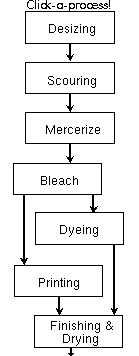

| PROCESS | INPUTS | WASTES | ||||
|---|---|---|---|---|---|---|
| Raw materials | Water | Energy | Liquid | Solid | Gas | |
| Enzymes or H2SO4 Yarn | 2 m3 [10] 5 m3 [22] (1) | Steam 5 GJ [13] (2) | BOD 14.8-16.1 Kg [8] 60 Kg [10] TS 66-70 Kg [8] FLOW 1-5 m3 [8] (1) (2) | Vapours | ||
| (3) | 10 m3 [22] (1) | Steam 5-11 GJ [13] (2)(4) | BOD 1.4-3.0 Kg TS 47-67 Kg FLOW 9-20 m3 [8](1) | |||
| NaOH, solution 10-30% by weight | 90 m3 [10] [22] (10)(1) | N.A. (2) | pH 5.5-9.5 BOD 10.5-13.5Kg TS 185-450 Kg [8] FLOW 110-150m3 (1)(7) | |||
| H2O2 or NaOCl | 1 m3 [22] 92-250 m3 [22] (9) (1) | Steam 10 GJ [13] (2)(5) | pH 8.5-9.6 BOD 5.0-15kg [8] TS 38-290kg (1) FLOW 1-60m3 | Vapours | ||
| See Tables 9,10 | See Table 8 (1) | N.A.(2) | Highly Variable (1) | |||
| See Tables 9,10,11 | 14 m3 [22] (1) | N.A.(2) | Highly Variable (1) | VOC See Table 11 | ||
| Finishing agent | 0.02 m3 [22] (1) | 1.9-3.7 GJ [13] 2.6-7.1 GJ [17] (2)(6) | (1)(10) | Vapours Particulate | ||
(1) Tables 4.1 and 4.2 list the amount of water used and waste load for Woven Fabric Finishing Mills.
(2) Total energy requirement for Woven Fabric Finishing is about 18700 KWh per tonne of finished fabric [14].
(3) There are two common methods of scouring: Kier boil and continuous scouring. According to Lund [12], the chemicals used to prepare the kier liquor for the pressure kier boil are NaOH 10-80 Kg, Na2CO3 10-30 Kg, Na2SiO3 2.5-10 Kg, pine oil soap and fatty alcohol sulfates. In continuous scouring, the goods as received from the desize wash are passed through a caustic solution (3-6% caustic soda plus wetting agent).
(4) Scouring process consumes about 5-6 GJ/t. Subsequent washing-off requires a further 5 to 6 GJ/t [13].
(5) The energy required for bleaching may amount to 5 GJ/t. Washing-off is an important part of the processing and again is found to require about 6 GJ/t according to reference [13].
(6) Energy required for drying only.
(7) According to Jones, [8], mercerization produces an effluent containing 5% NaOH. The lower pH figure given also in this reference seems too low if the concentration of sodium hydroxide is taken into account.
(8) As stated in reference [10] this figure for water consumption corresponds to mercerizing machines with countercurrent washing.
(9) Reference [22] contains a compilation of water usage data for different industrial sectors and operations. The differences in the data given are due to the different sources from which they were extracted and no explanation is given to justify the wide variation.
(10) Finishing is normally a continuous process that produces little or no wastewater [6].
| Process Description | Minimum | Median | Maximum |
|---|---|---|---|
| Simple | 12.5 | 78.4 | 275.2 |
| Complex | 10.8 | 86.7 | 276.9 |
| Complex+Desizing | 5.0 | 113.4 | 507.9 |
| Units | Type of Process | BOD | COD | TSS | O&GG | Phenol | Cr | Sulphide |
|---|---|---|---|---|---|---|---|---|
| mg/l | Not Described | 650 | 1200 | 300 | 14 | 0.04 | 0.040 | 3.0 |
| Kg/t | Simple (1) | 22.6 | 92.4 | 8.0 | 9.1 | 8.2 | 4.3 | 7.6 |
| Complex (2) | 32.7 | 110.6 | 9.6 | 3.8 | 7.7 | 2.6 | 12.5 | |
| Complex + Desizing | 45.1 | 122.6 | 14.8 | 4.1 | 13.1 | 20.9 | N.A. |
(1) Processes such as desizing, fibre manufacturing preparation and dyeing.
(2) Simple manufacturing with additional operations such as printing and dyeing.